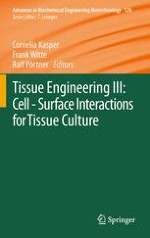2012 | OriginalPaper | Buchkapitel
Stem Cell Differentiation Depending on Different Surfaces
verfasst von : Sonja Kress, Anne Neumann, Birgit Weyand, Cornelia Kasper
Erschienen in: Tissue Engineering III: Cell - Surface Interactions for Tissue Culture
Verlag: Springer Berlin Heidelberg
Aktivieren Sie unsere intelligente Suche, um passende Fachinhalte oder Patente zu finden.
Wählen Sie Textabschnitte aus um mit Künstlicher Intelligenz passenden Patente zu finden. powered by
Markieren Sie Textabschnitte, um KI-gestützt weitere passende Inhalte zu finden. powered by
